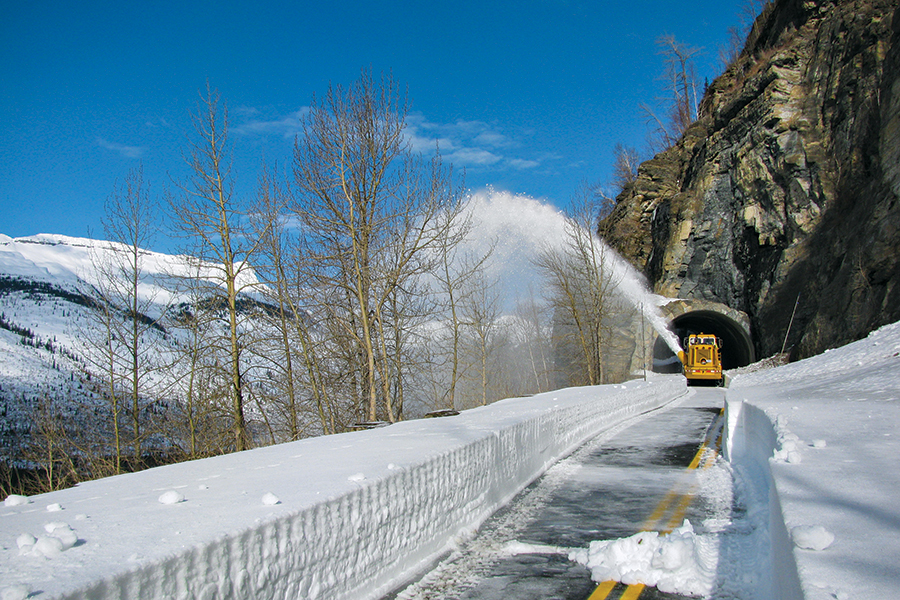Plows Push Past Rim Rock on Sun Road
With Glacier National Park set to reopen on a limited basis June 8, hikers and bikers may begin exploring lower sections of Sun Road
By Tristan Scott
When COVID-19 forced the temporary closure of Glacier National Park in late March, many residents of Northwest Montana assumed the pandemic would stall one of the region’s most prominent rites of spring — the plowing of the famed Going-to-the-Sun Road.
Turns out, not even a global pandemic could halt the rumbling fleet of safety-yellow snowplows and excavators that converge each April on Glacier’s iconic alpine highway, although this year’s daunting task is being dispatched by a smaller crew in order to comply with social-distancing guidelines.
Still, the plows are making progress clearing the Sun Road of its winter weight, which is a more complicated task than some observers might think.
The majority of visitors to the Sun Road observe the spectacular 50-mile trans-mountain expanse during the busy summer months, often through their windshields and on dry pavement. But a small, hardscrabble tribe of park personnel spends the months of April, May and much of June clearing snow and hazards from the scenic corridor, which isn’t maintained during winter.
The intrepid park employees who are assigned each spring to pioneer the route to Logan Pass must carve a path through heavy, avalanche-prone snowpack, which can tower 80 feet above the roadbed in places, obscuring all but the faintest impression of the ribbon of asphalt etched into the mountain faces. At Glacier, crews face a challenging combination of deep, wind-packed snow, avalanches, rockfall, and steep drop-offs alongside the numerous turns on the narrow road.
The Sun Road corridor has more than 40 major avalanche paths that can release destructive snow slides onto the road without a moment’s notice, and the road-crew members know them by name — The Grizzly, Swede Point, Weeping Wall, Alps of America, and Haystack Creek. Not only do those slide paths deposit tons of debris onto the roadbed, but they present a safety hazard, which crews minimize by relying on avalanche forecasters and establishing safety zones.
The safety of crew members has improved by technological advances through the years, as well as with the advent of an avalanche-forecasting program in 2002, which is facilitated by the U.S. Geological Survey in partnership with the National Park Service.
This spring marks the first time that a global pandemic threatened to stymie the plowing operations, however.
Faced with the decision to delay the plowing of the Sun Road due to the spread of COVID-19, or move forward as scheduled, Glacier Superintendent Jeff Mow said much of the plowing and excavation machinery requires surface snowpack to perform its job without ripping up the blacktop — if the surface snow melts out, a window of opportunity is lost, he said.
“Having the Going-to-the-Sun Road open might be the one thing we’re capable of doing,” Mow said shortly after announcing Glacier’s temporary closure. “It may be limited, and it may be that not all the trails are open, but having that road open is probably the single most important thing in terms of economic recovery that we at the National Park Service could be doing locally.”
On June 8, Glacier National Park will reopen its west entrance to recreational access for the first time in more than two months, following a complete closure since March 24. Although services will be available on a limited basis, the reopening will allow hikers and bikers to access sections of the Sun Road that are clear of snow but not yet open to motorized vehicles, which are currently prohibited beyond Lake McDonald Lodge.
According to the park’s social media channels, the plowing crew has hit the Rim Rock section, about two miles below Logan Pass on the west side. East entrances from the Blackfeet Indian Reservation will remain closed to visitor access.
Initially, visitors can enter the park from the west entrance until 4:30 p.m. each day, and are allowed to remain inside the park after the entrance gates close, allowing them to enjoy evening rides and hikes.
The park’s reopening priorities center on protecting the public and employees from transmission risks associated with COVID-19, including through a variety of mitigation actions consistent with local, state, tribal, and federal guidance, the release states. The park will actively monitor changing conditions (in the park and in surrounding counties); and will maintain flexibility to expand, adjust, or contract operations as conditions warrant.
In addition to face coverings, visitors should remember to pack bear spray and warm clothes if they venture into Glacier’s high country. According to a recent photo of a grizzly bear loping along a snowfield near recent plowing operations, the wildlife has been abundant despite the park’s closure.
“Even the bears appreciate the road crew’s work plowing the Going-to-the-Sun Road,” according to a Facebook post on Glacier’s page.